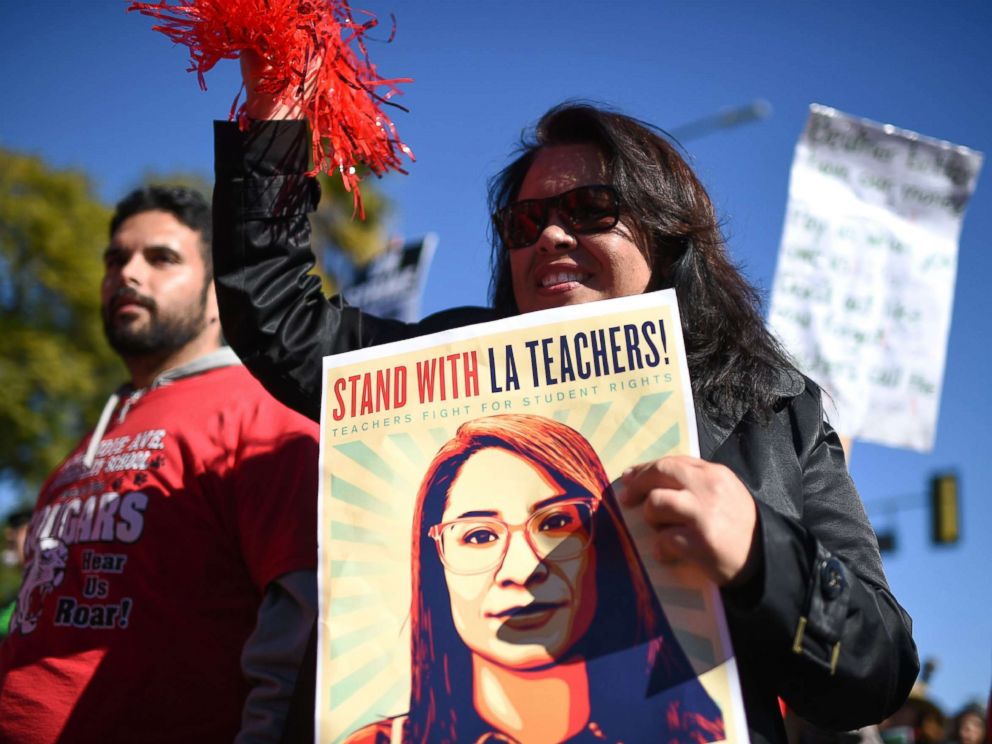LAUSD teachers union and school district reach tentative deal to end strike

Los Angeles teachers are poised to end their first strike in 30 years after union leaders reached a tentative deal Tuesday with the L.A. Unified School District.
The Board of Education is expected to move quickly to ratify the deal, which must be officially approved by United Teachers Los Angeles through a vote of its members.
Union leaders have said they will not end the strike until their members ratify a contract, but also said they have a system in place that could allow members to vote within a matter of hours. That means teachers are likely to be back at work on Wednesday.
Regardless, schools will be open on Tuesday, managed by skeleton staffs of administrators and employees who are not on strike, just as they were last week. More than two-thirds of students did not come to campuses during the first week of the strike.
The final key details of a tentative deal were worked out during an all-night bargaining session that ended at 6:15 a.m.
Less than an hour later, teachers held another rally at a school complex within walking distance of district headquarters.
The union had planned to have members march to district headquarters after a 10:30 a.m. rally at City Hall, but canceled the march after the agreement was reached.
The tentative pact was announced at a 9:30 a.m. news conference at City Hall by L.A. schools Supt. Austin Beutner, union President Alex Caputo-Pearl and L.A. Mayor Eric Garcetti, who mediated the final negotiations with members of his senior staff.
“Today is a day full of good news,” Garcetti said in announcing the agreement, which he said came after a “21-hour marathon that wrapped up just before sunrise.”
“Everyone on every side has worked tirelessly to make this happen,” the mayor said.
The tentative deal includes what amounts to a 6% raise for teachers, although details of how it will go into effect were not immediately available.
It also includes some help to reduce class sizes and removes a contract provision that allows the school district to increase class sizes in times of economic hardship. It was not immediately clear how that issue would be dealt with going forward.
But, said Caputo-Pearl: “We have started down a real path to address class size.”
Beutner said the agreement marked the beginning of a community conversation.
“Public education is now the topic in every household in our community,” he said. “Let’s capitalize on that. Let’s fix it.”
From the beginning, the strike was about larger issues than pay raises.
Caputo-Pearl framed it as a fight over the future — even the survival — of traditional public education. Beutner framed the negotiations as a matter of what the nation’s second-largest school system could afford to do within the limits of its resources.
Whether the union made progress in that battle is open to question, but its leaders will take to their members a deal that they say will improve working conditions for teachers and learning conditions for students.
In its last offer before the strike, the district proposed class size reductions that fell short of the dramatic changes the union wanted and said it would provide a nurse five days a week in elementary schools and a full-time librarian for all middle and high schools. The district also offered to add an academic counselor at high schools, although the student-to-counselor ratio would remain high.
The union criticized this proposal because the district did not commit to keeping these positions longer than one year.
District officials said the union demands were far more than the nation’s second-largest school system could afford.
The union had put forward a lengthy proposal that touched on a wide range of issues important to its various members, including teachers at all grade levels, and those who teach early education, adult education, bilingual education and children with disabilities.
Though raises will help all members, some items on the union’s original expansive list of demands dropped off the table even before the strike.
The union could have held out longer — and some insiders originally envisioned a longer strike. But public support, which has been strong, might have eroded if the effort dragged on.
Because negotiations took nearly two years, much of the new deal covers a time period that already is past. The agreement, if approved, will expire at the end of June 2020, meaning that it soon will be time to bargain again.
